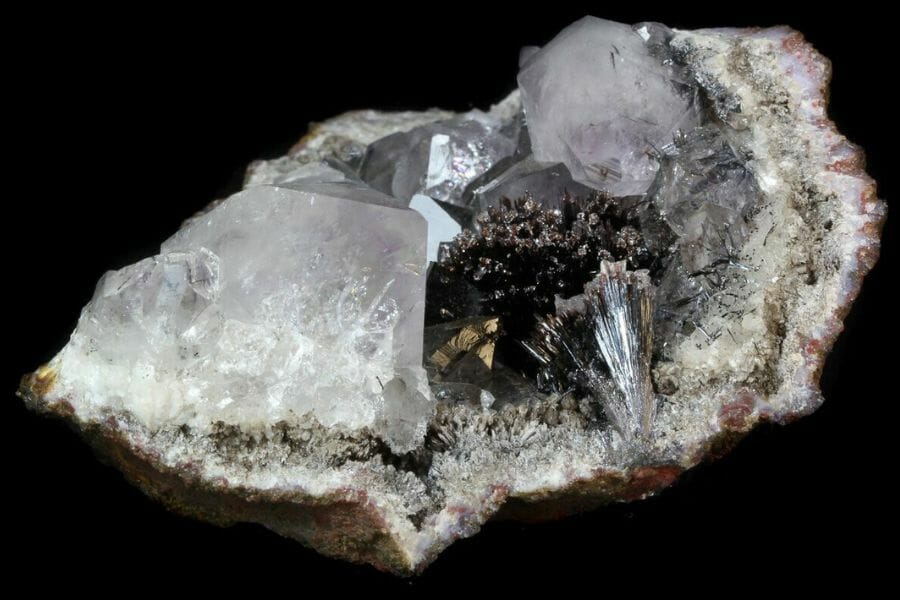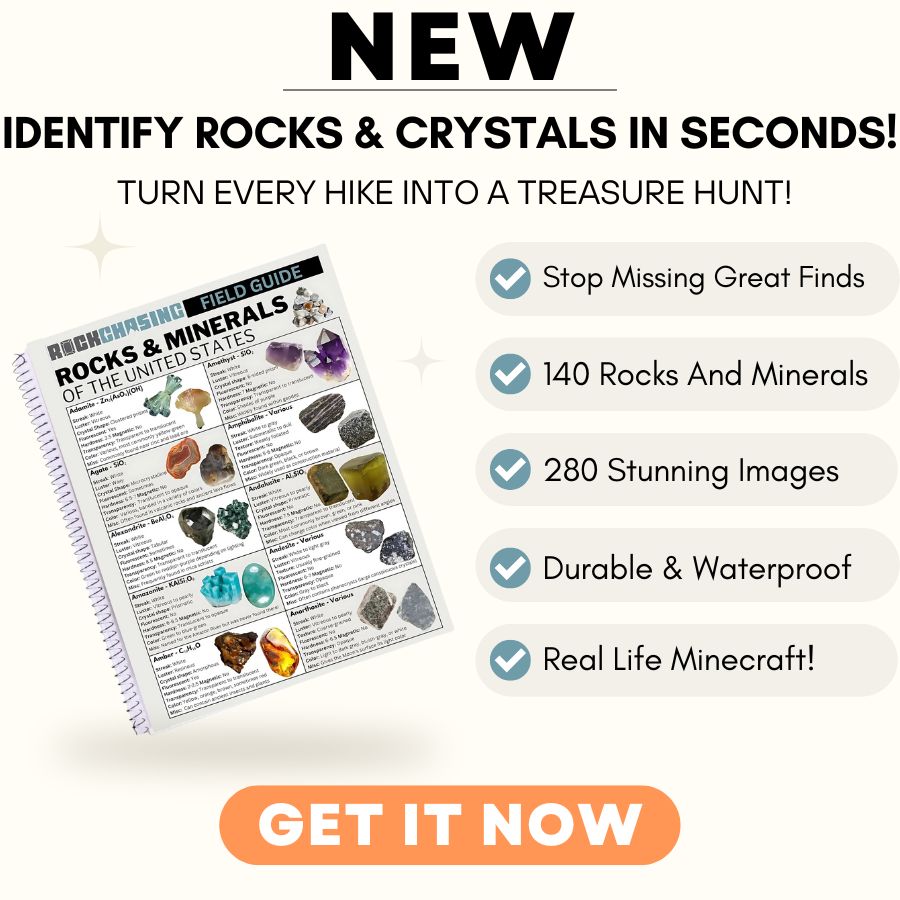Geodes are like nature’s surprise eggs, filled with sparkling crystals inside a plain-looking rock. Our state is a treasure trove for these hidden gems, with its many different landscapes that make it perfect for rock hounds.
If you’re itching to crack open your own crystal-filled wonder, you’re in the right place!
This article will show you the best spots in our state to find geodes. We’ll also share some handy tips to make your geode hunting adventure a success.
So grab your hammer and get ready to discover the beauty hiding in ordinary-looking rocks all around this state!
How Geodes From Here
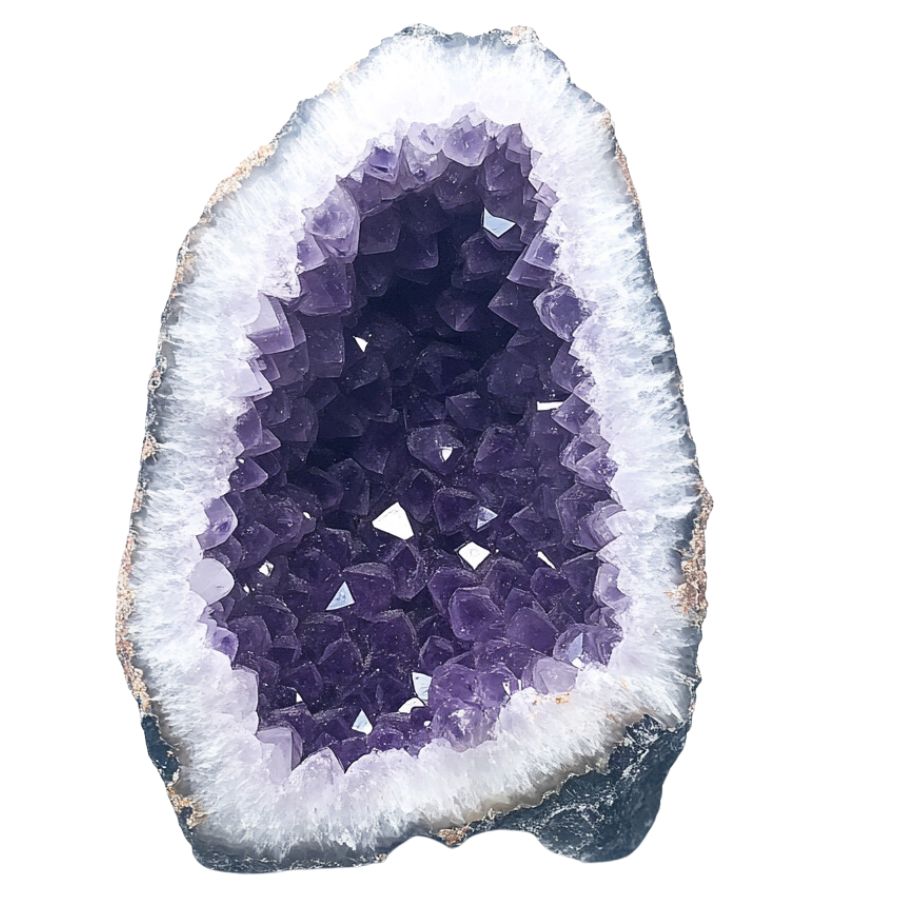
Geodes form when bubbles in volcanic rocks or spaces in sedimentary rocks get filled with minerals over time.
First, water rich in minerals like quartz or calcite seeps into the hollow space. As the water evaporates, it leaves behind the minerals, which slowly build up layer by layer.
Eventually, these minerals create a crystal lining inside the geode. The outer shell stays rough, while the inside becomes a sparkling treasure.
The process can take thousands, even millions, of years, making each geode a unique and beautiful time capsule of Earth’s natural forces.
The Types Of Geodes Found in the US
There are many fascinating varieties of geodes that can be found across the United States, including in our own state. Each type is distinctly beautiful and intriguing:
Amethyst Geode
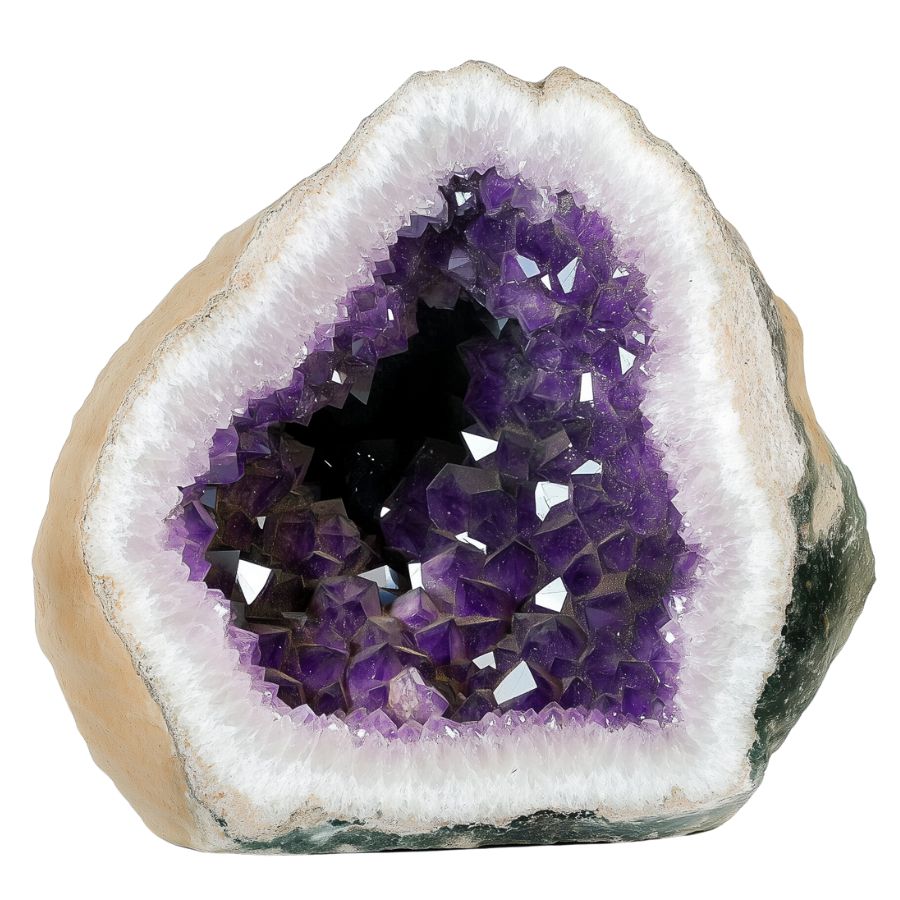
Amethyst geodes look plain on the outside, like a potato. But crack them open, and you’ll find stunning purple crystals. These crystals can be light lavender or deep purple.
The structure of crystals inside can vary widely. Some are tiny and densely packed, creating a sparkling surface. Others form large, distinct points that jut inwards.
The color range is impressive too, from pale lilac to deep royal purple. Some amethyst geodes develop unique features. “Stalactites” of amethyst might hang from the top.
In rare cases, you might find a water bubble trapped inside, a remnant from the geode’s formation millions of years ago.
Citrine Geode
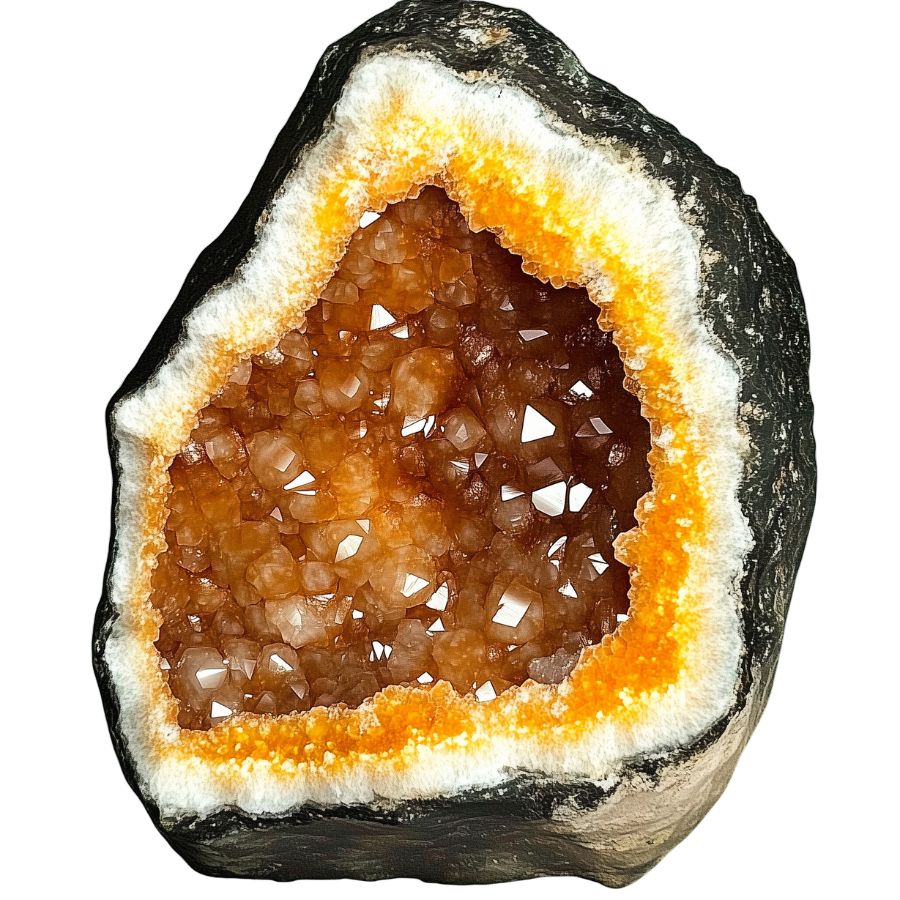
Citrine geodes are eye-catching rocks with golden yellow to orange crystals inside. They sparkle when light hits them, looking like sunshine trapped in stone. The colors come from iron mixed in with the quartz.
Unlike many gemstones, citrine’s color is often evenly distributed throughout the crystal.
Most citrine on the market isn’t natural. It’s actually heat-treated amethyst. This process turns the purple amethyst into vibrant citrine. Natural citrine is rarer and often has a more subtle color.
Pyrite Geode
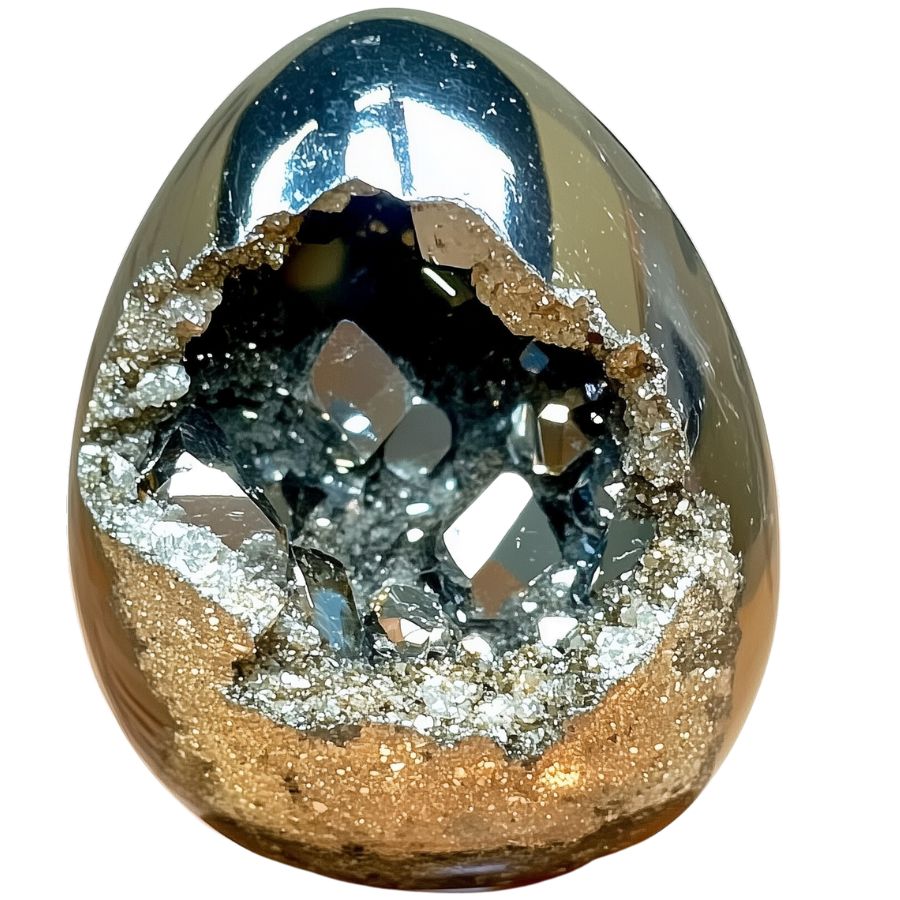
Ever cracked open a rock and found gold inside? Well, not real gold, but something that looks just like it. That’s a pyrite geode. Pyrite is called “fool’s gold” because it’s so shiny and golden.
Inside these geodes, pyrite forms in cool shapes. Sometimes it’s perfect cubes. Other times its clumps or even round balls called “pyrite suns”.
Pyrite has a fun history. People have been mixing it up with real gold for thousands of years. That’s how it got its nickname.
Selenite Geode
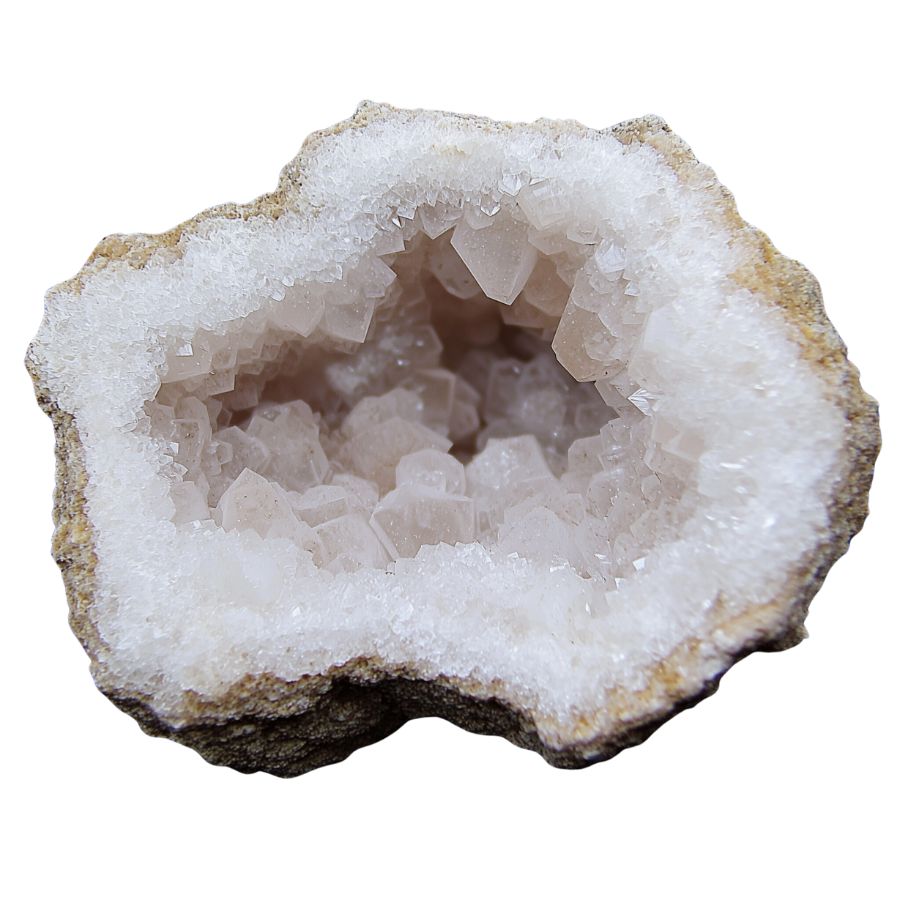
Selenite geodes stand out from the crowd. They’re white and see-through, with a glassy look. When you open one up, you’ll see crystals that look like they’re made of ice or moonlight.
Unlike harder geodes, selenite is soft. You can scratch it with your fingernail! This softness means you need to handle it carefully. But it also means selenite can be shaped into beautiful forms easily.
One cool thing about selenite is how it plays with light. Hold it up to a lamp, and you’ll see the light shine right through it. This makes selenite geodes popular for decorative lamps and light fixtures. They add a magical glow to any room.
Celestite Geode
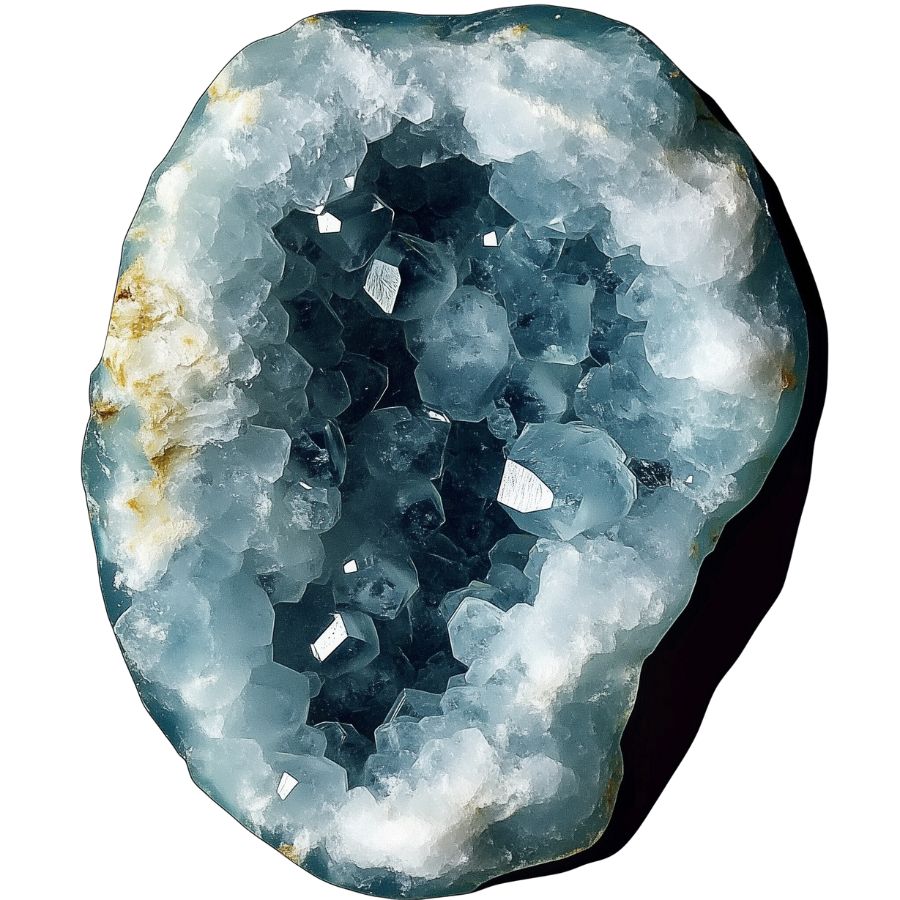
Celestite geodes are like pieces of sky trapped in rock. Their crystals are typically a delicate blue, ranging from almost colorless to deep sky blue. In rare cases, celestite can form in other colors. Pink celestite is highly prized by collectors.
One unique feature of celestite is its perfect cleavage. This means the crystals can be easily split into rhombohedral shapes.
These geodes form in a unique way. They start as nodules of a soft mineral called alabaster. Over time, this dissolves and is replaced by celestite crystals. Some celestite geodes are huge, like the famous Crystal Cave in Ohio.
Celestite isn’t just pretty to look at. It’s used to make strontium, an element with many uses. You’ll find strontium in fireworks, where it creates red colors. It’s also used in making TV screens and ceramics.
Jasper Geode
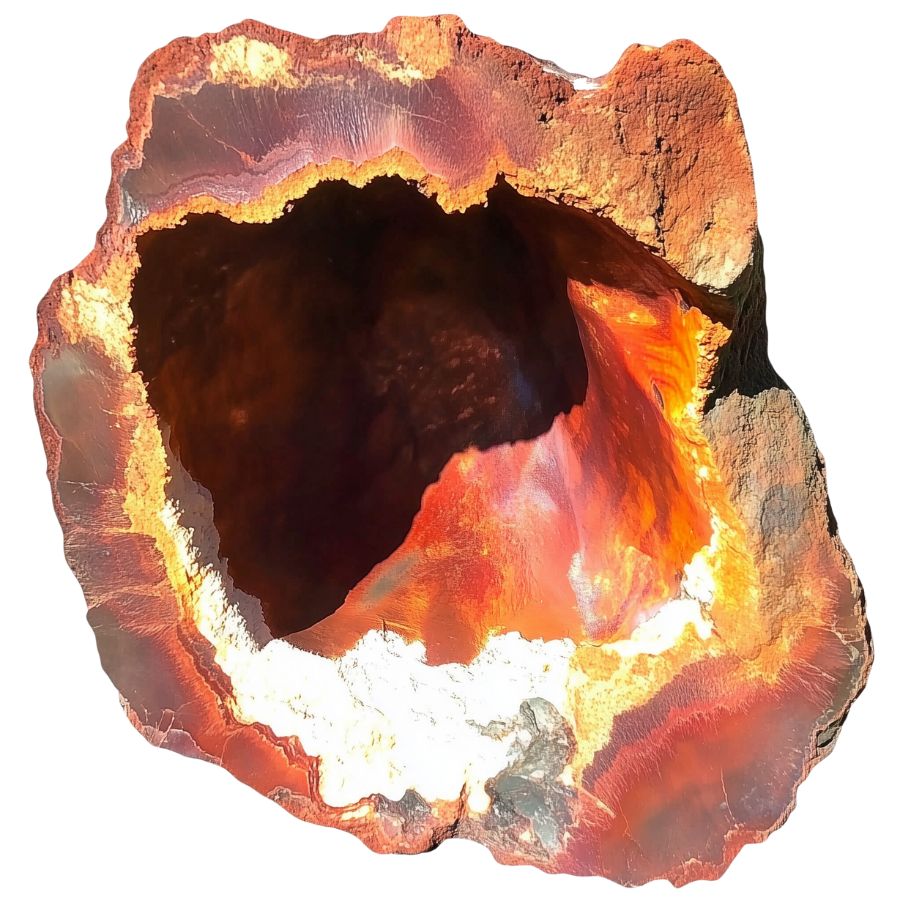
Jasper geodes are the chameleons of the mineral world. They can appear in almost any color, often with multiple hues in a single specimen. Patterns can range from solid colors to intricate swirls, bands, or spots.
One fascinating type is picture jasper. These geodes contain patterns that resemble landscapes, with “skies,” “mountains,” and “rivers” visible in the stone. Each one is like a miniature painting created by nature.
Some jasper geodes contain orbicular patterns – spherical structures that formed as the jasper solidified. These create eye-catching bull’s-eye or flower-like designs in the stone, making each piece truly one-of-a-kind.
Carnelian Geode
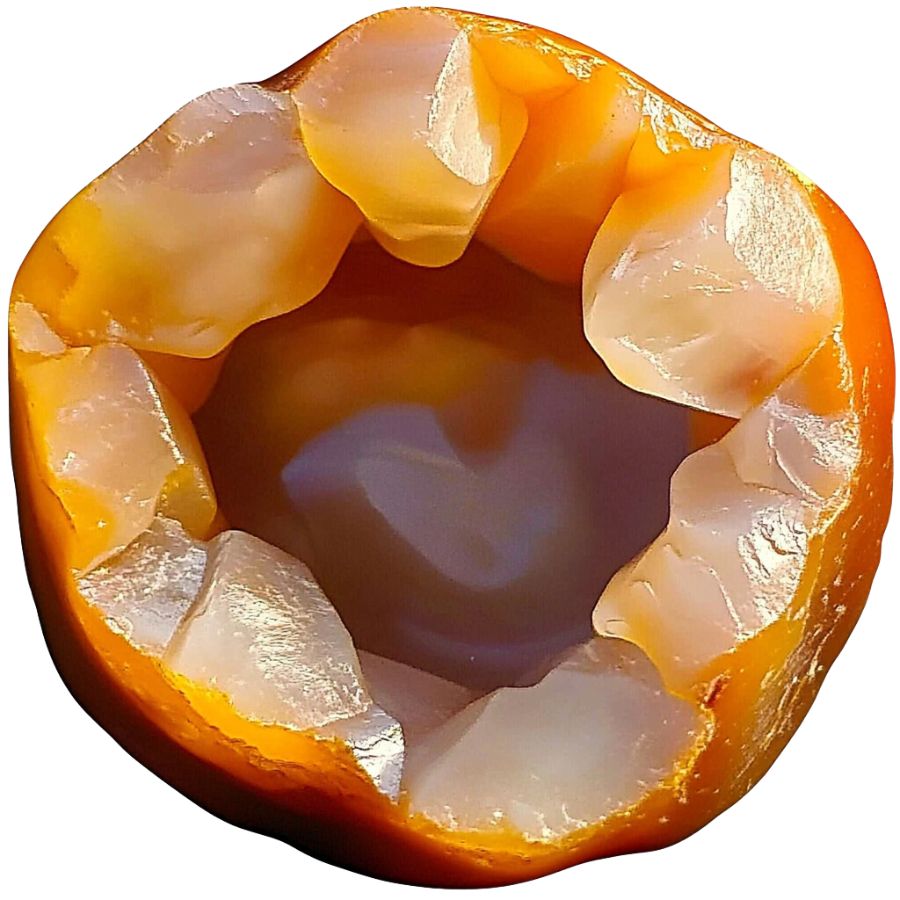
Carnelian geodes have vibrant orange to reddish-brown colors. They can be somewhat see-through, which makes them look even more interesting. The bright colors come from the iron in the stone.
These geodes stand out from other similar stones. They’re brighter than sard, which is usually darker and more brownish. And unlike agate, carnelian doesn’t have bands or stripes.
Carnelian has been popular for a long time. Ancient Egyptians and Greeks used it to make special rings. It’s tough enough for everyday jewelry.
Some people heat or dye carnelian to make its color even brighter. This makes it a favorite for both rock collectors and jewelry lovers.
Fluorite Geode
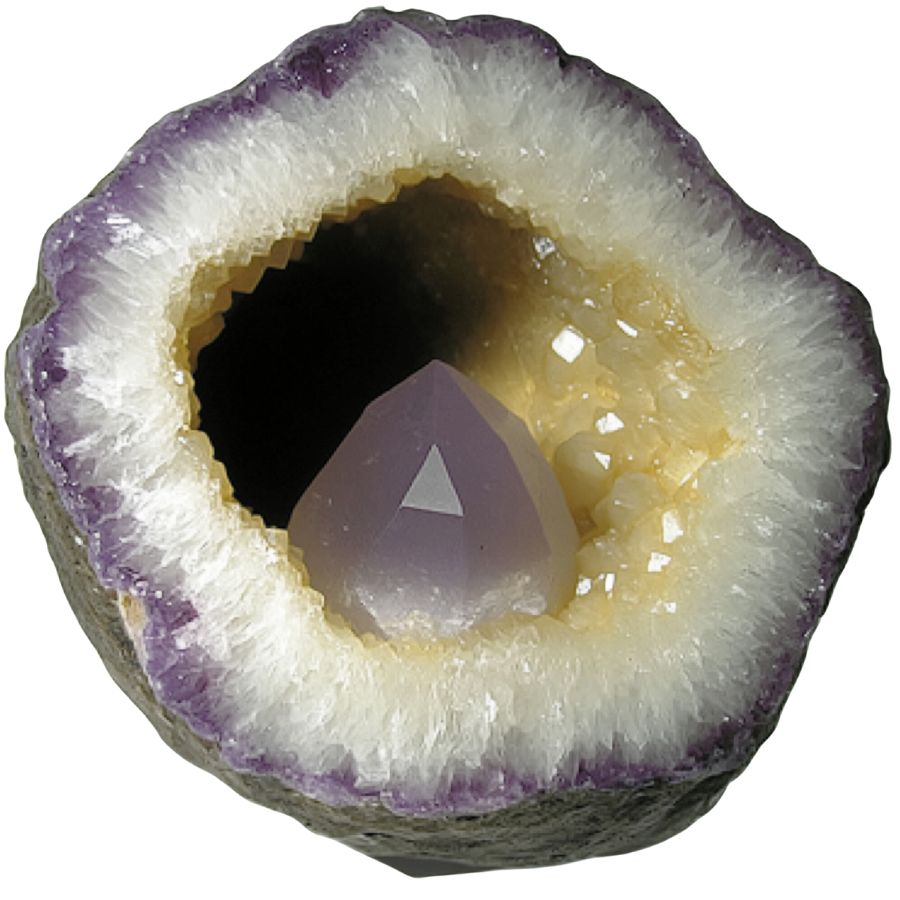
Fluorite geodes are like nature’s rainbow. They come in many colors – purple, green, blue, yellow, and sometimes even clear or black. When you open one up, you might see cube-shaped or eight-sided crystals inside.
What makes fluorite special is that you can often see more than one color in a single stone. This is different from many other geodes. Also, fluorite has a unique way of splitting when it breaks.
A cool fact: fluorite glows blue under ultraviolet light. This was first discovered back in 1852. Because of its many colors and this glowing ability, fluorite is sometimes called the “most colorful mineral in the world.”
Scolecite Geode
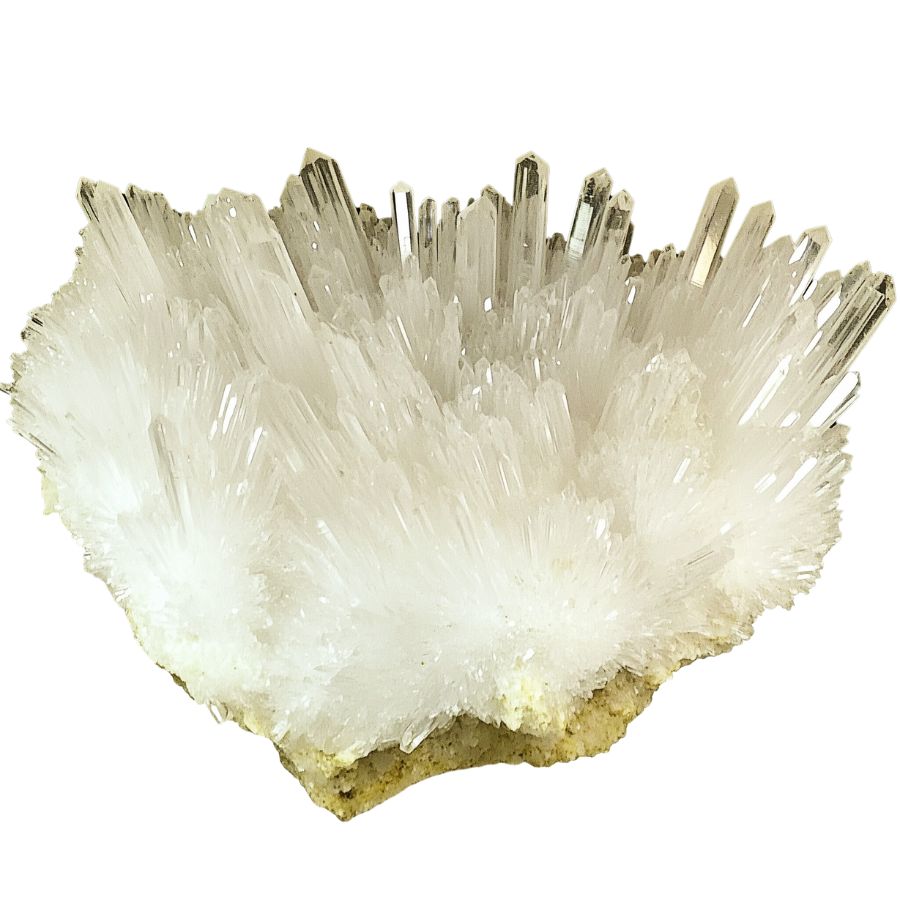
Scolecite geodes are like tiny crystal caves. They’re usually white or colorless, but sometimes you might find pink, yellow, or green ones.
What makes them special is the crystals inside. They look like thin needles or delicate hairs, all pointing out from the center.
These geodes are different from others because of their crystal shape. Instead of blocky or chunky crystals, scolecite has these fine, hair-like ones. This gives them a unique, delicate look.
Scolecite has an interesting property – it can hold a lot of water in its structure. This means it can absorb and release water easily. This makes scolecite useful in various ways, not just as a pretty rock to look at.
Apophyllite Geode
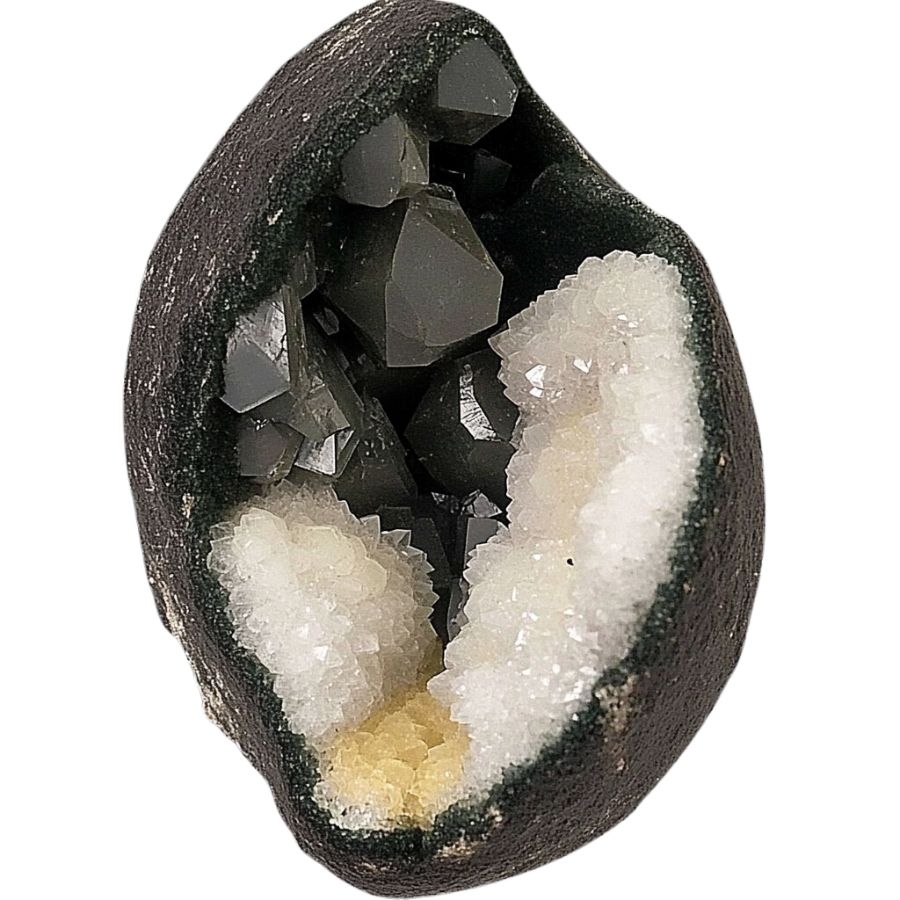
Apophyllite geodes are like nature’s disco balls. They often have dark or black crystals inside a hollow rock. These crystals can be see-through or slightly cloudy, with cube-like or flat shapes.
What makes apophyllite geodes stand out is how the crystals form. They grow in round clusters that look like tiny disco balls. This unique formation is rare and makes them special to rock enthusiasts.
Collectors really prize these “disco ball” clusters. They’re not common, which makes them valuable to people who love unusual rocks. The way apophyllite crystals catch and reflect light adds to their appeal, making them fascinating to look at and study.
What Rough Geode Looks Like
Identifying a rough geode might seem tricky, but with a few tips, you can spot one even if you’re not a rock expert. Here’s how you can do it.
Look for a Rounded Shape
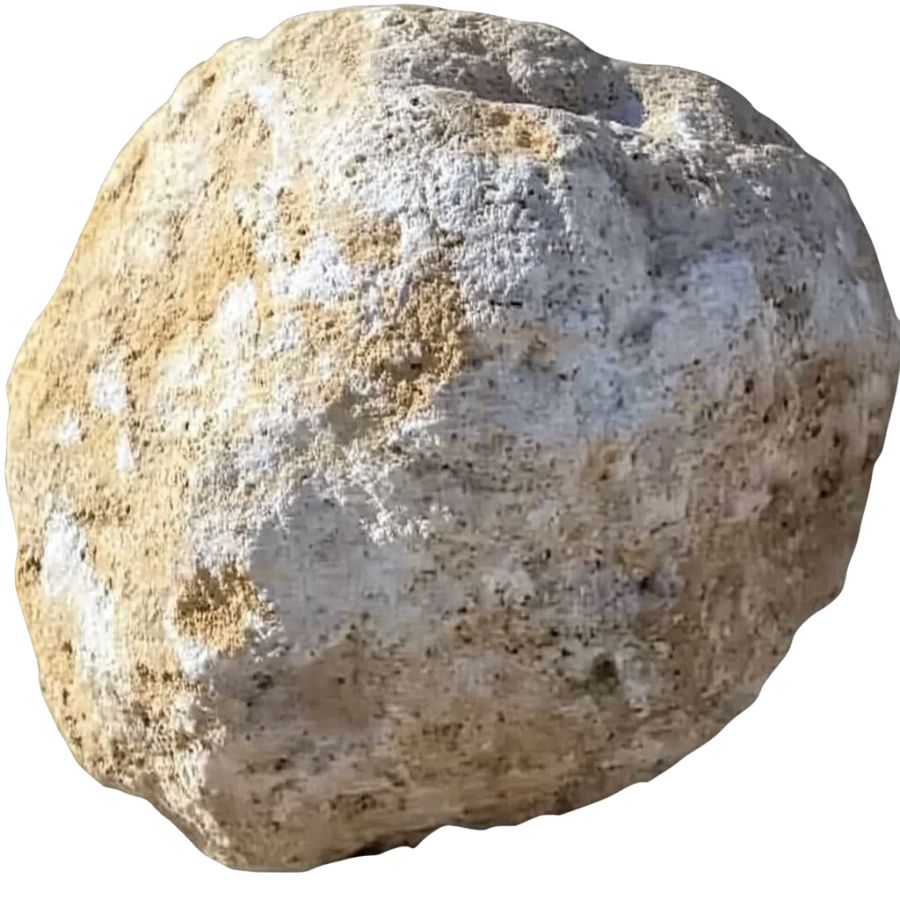
A rough geode often has a rounded or egg-like shape. It might not be perfectly round but look for a generally bulbous form.
When you’re out searching, skip the flat, jagged rocks. Geodes usually have smoother exteriors because they’ve been rolling around in rivers or other environments for a long time.
Check for a Dull, Bumpy Surface
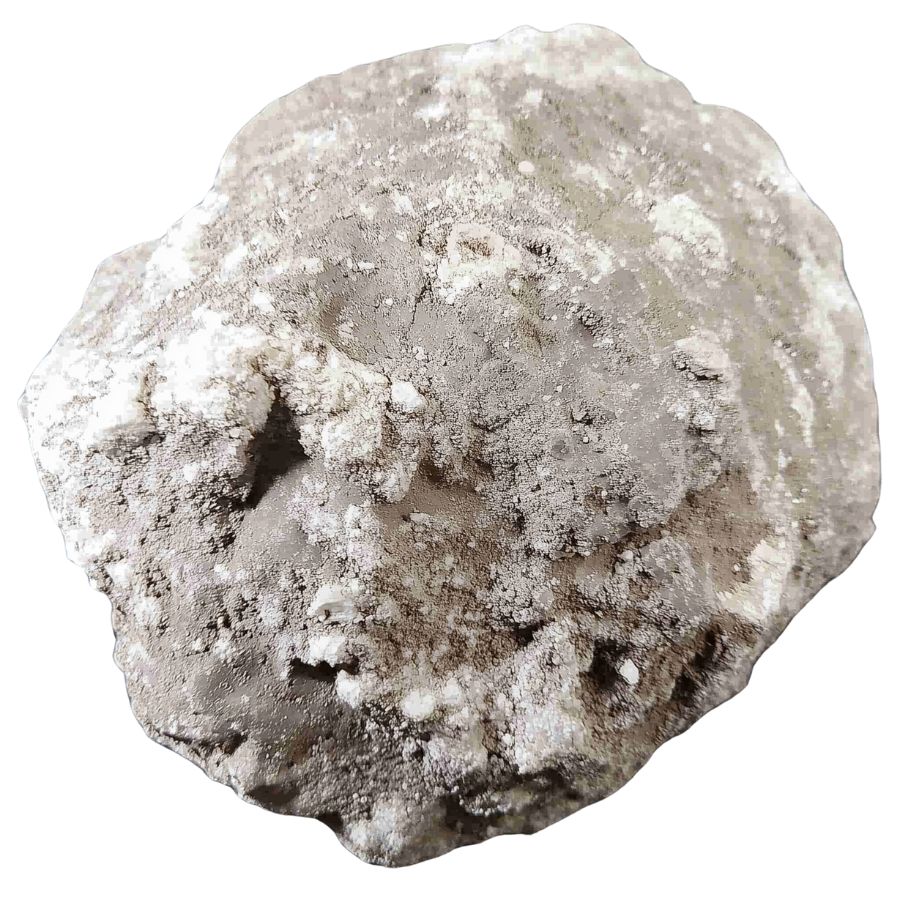
The outside of a geode isn’t usually shiny. Instead, it’s dull, bumpy, and a bit rough.
Imagine a potato or a clump of dirt with some bumps and dents. That’s how a geode might look before it’s cracked open.
The outside won’t give away much of what’s inside, so don’t be fooled by its ordinary appearance.
Test the Weight
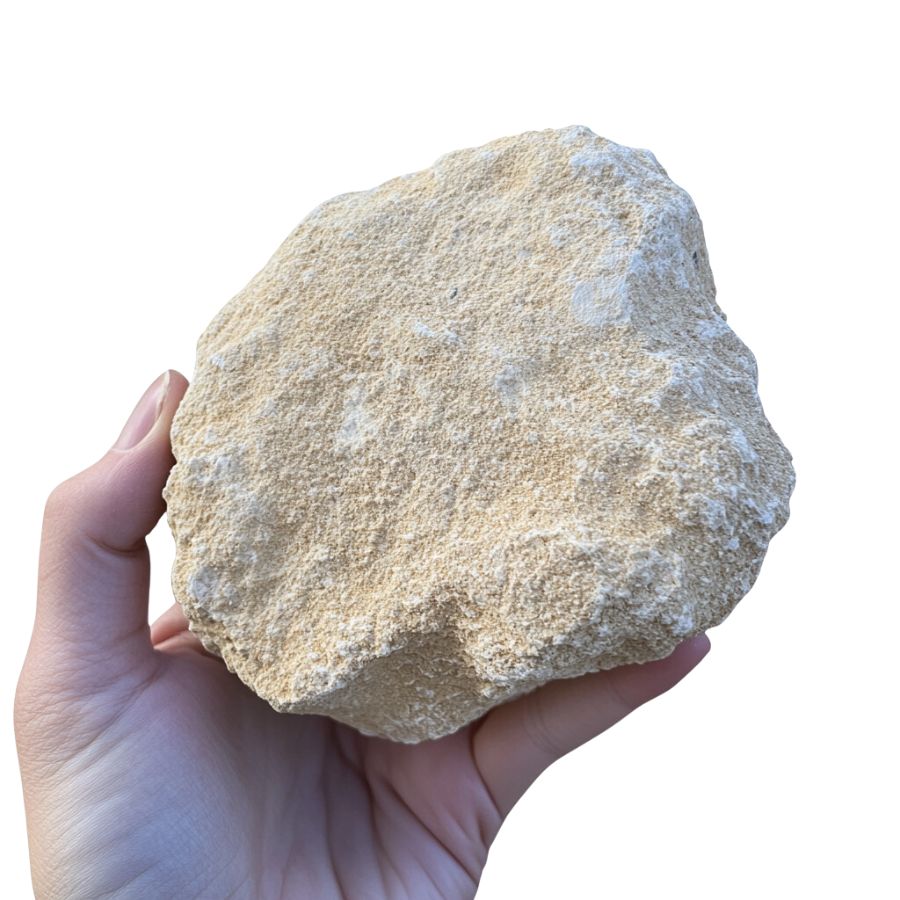
Pick up the rock. Does it feel lighter than it looks? That’s a good sign!
Geodes are hollow or partially hollow, which makes them lighter than solid rocks of the same size. If it feels unexpectedly light, you might have found something special.
Look for Tiny Crystals or Mineral Patches
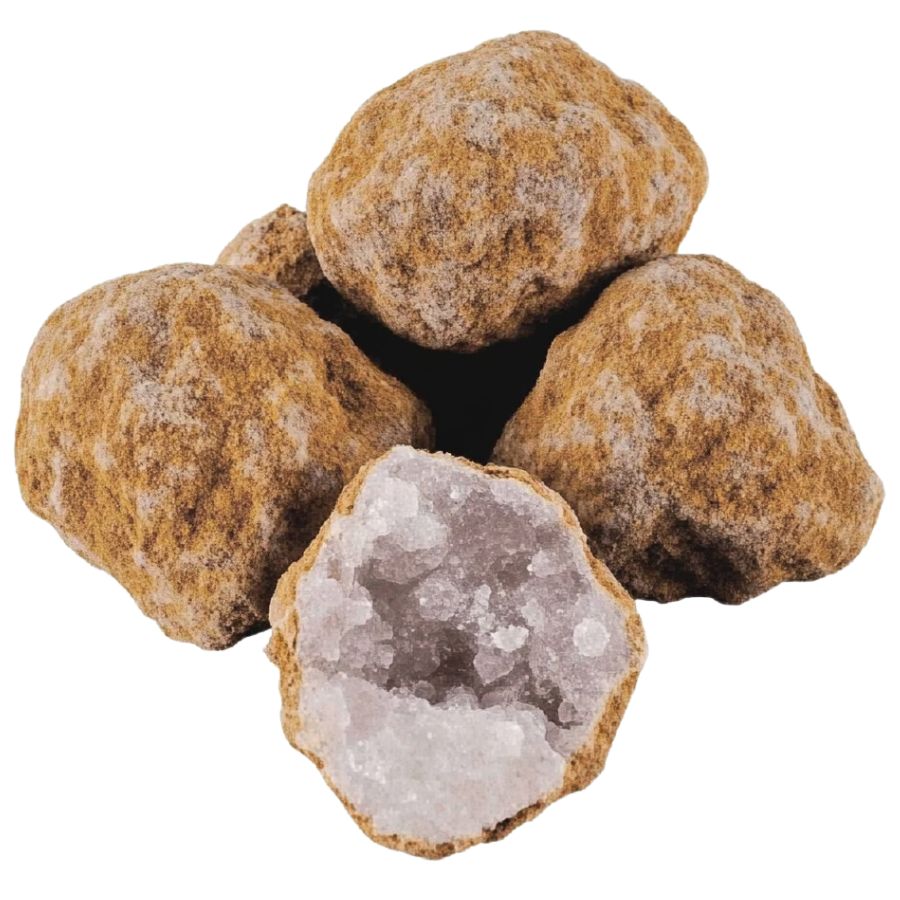
Sometimes, you can spot small crystals or mineral deposits on the outside. These could look like tiny sparkles or specks of color.
While the outside of a geode is usually dull, a little peek of what’s inside might show through. Keep an eye out for these hints, especially if you’re in a known geode-rich area.
Tips on Where to Look
Once you get to the places we have listed below there are some things you should keep in mind when you’re searching:
Explore Riverbeds and Streams
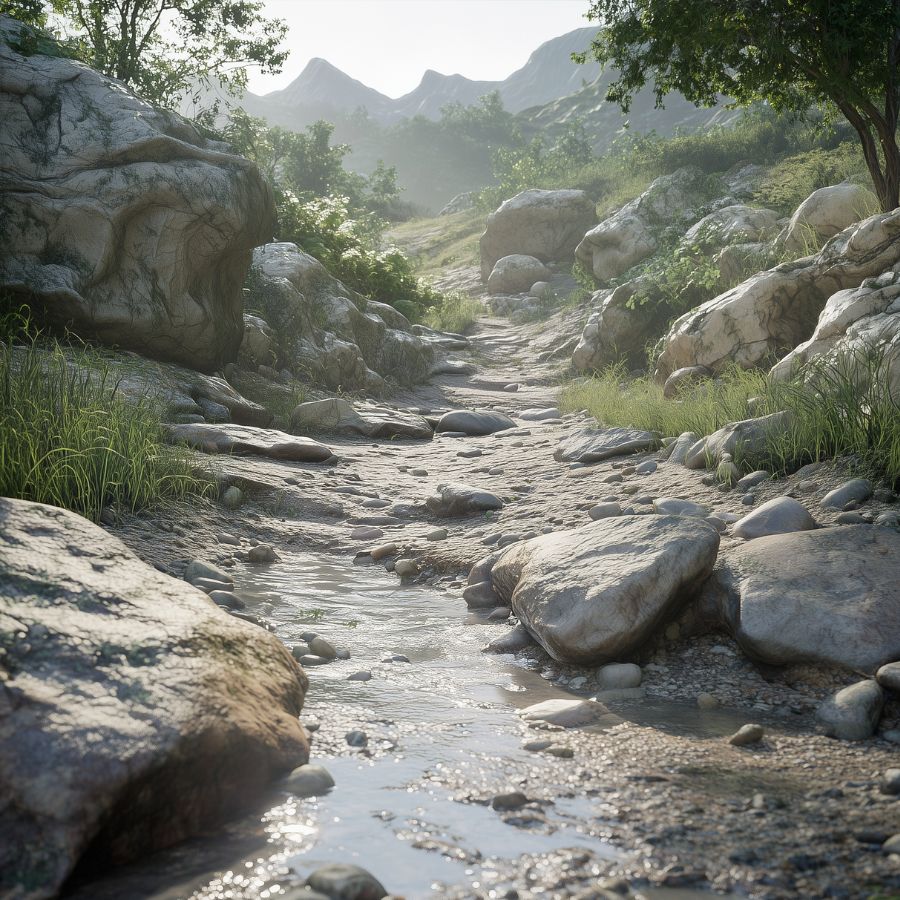
Geodes often form in riverbeds or streams. Water flow smooths out their rough edges and deposits them in these areas.
When exploring, focus on gravel bars or the edges of rivers where rocks naturally gather.
Search in Sedimentary Rock Layers
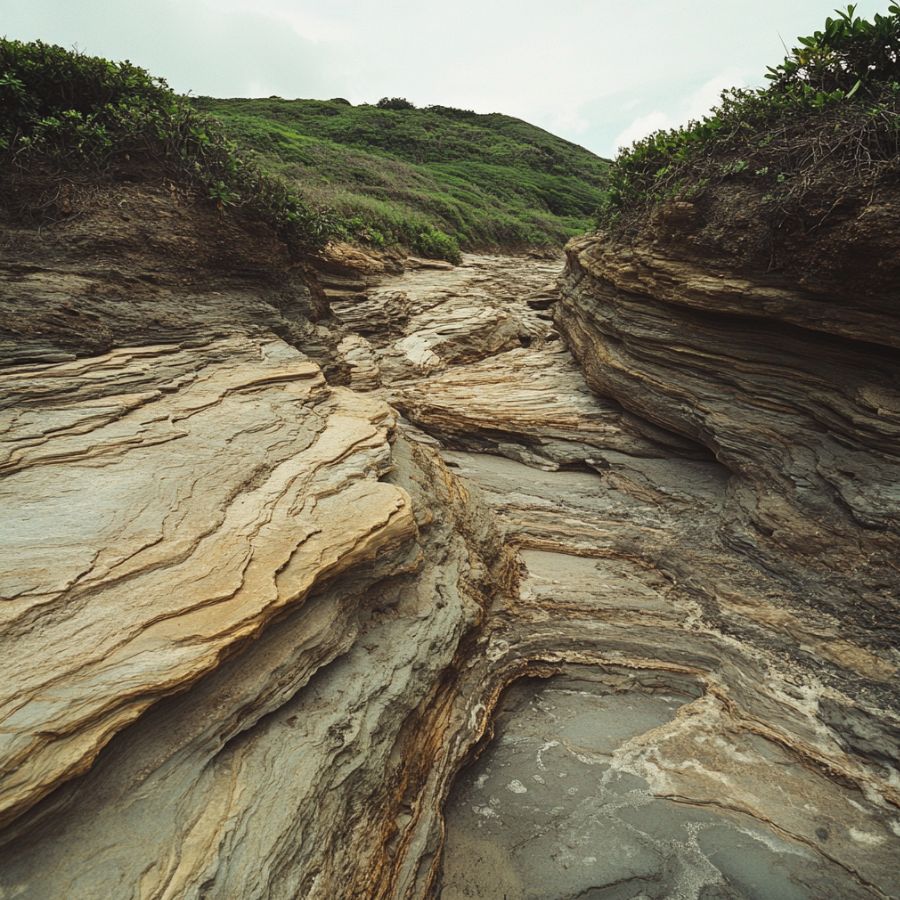
Sedimentary rocks, like limestone, are prime spots for geodes. These rocks form in layers over time, trapping minerals inside.
Look for areas where sedimentary rocks are exposed, such as cliffs or road cuts.
Visit Old Mines or Quarries
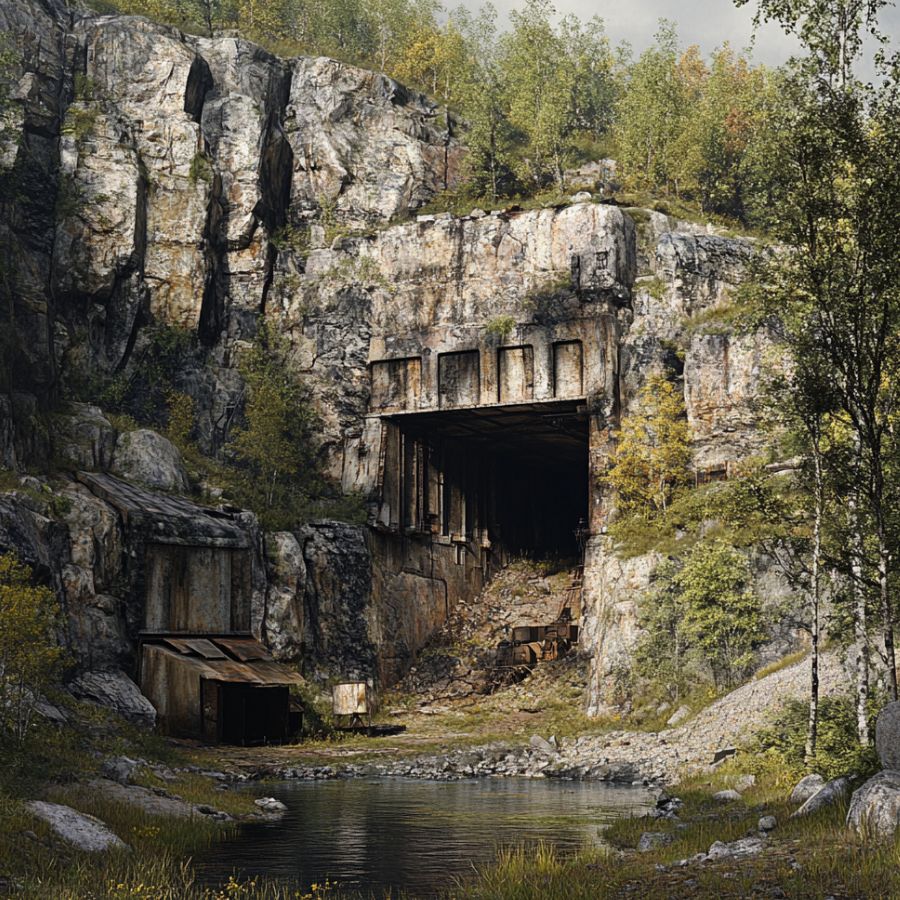
Abandoned mines and quarries are excellent spots for geode hunting.
Workers often missed geodes while digging for other materials. Explore the tailings or leftover rock piles for hidden treasures.
Explore Hills and Rock Outcrops
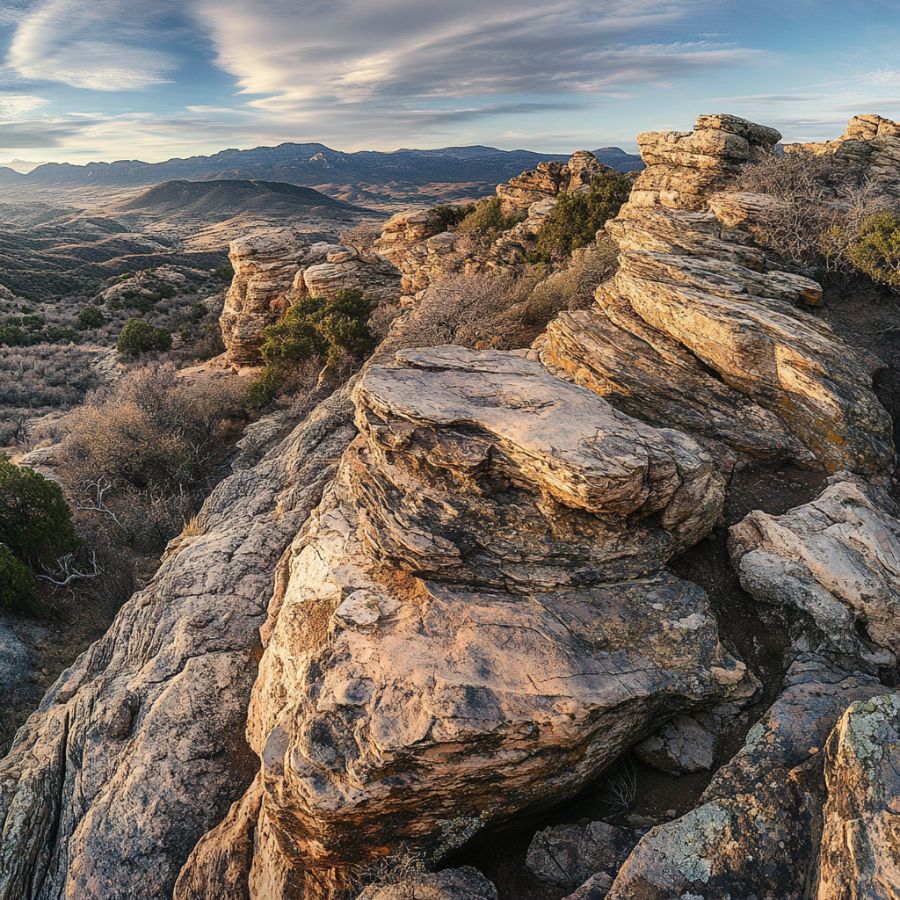
Hills and rocky outcrops often reveal geodes. As erosion wears away the softer rock, it exposes the harder geodes.
Look for areas with exposed rocks and keep an eye out for rounded shapes.
The Types of Geodes You Can Find in Missouri
Missouri is home to a variety of geode types that can also be found throughout the world. In fact, the value of a geode depends on its type. Below is a list of those that can be discovered in this area:
- Aragonite geodes
- Barite geodes
- Calcite geodes (Pink and Black Dogtooth)
- Chalcopyrite geodes
- Dolomite geodes
- Fluorite geodes
- Goethite geodes
- Honessite geodes
- Malachite geodes
- Marcasite geodes
- Millerite geodes
- Pyrite geodes
- Pyrolusite geodes
- Quartz geodes
- Smithsonite geodes
- Siderite geodes
- Sphalerite geodes
- St. Francisville geodes
- Szomolnokite geodes
The Best Places To Find Geodes in Missouri
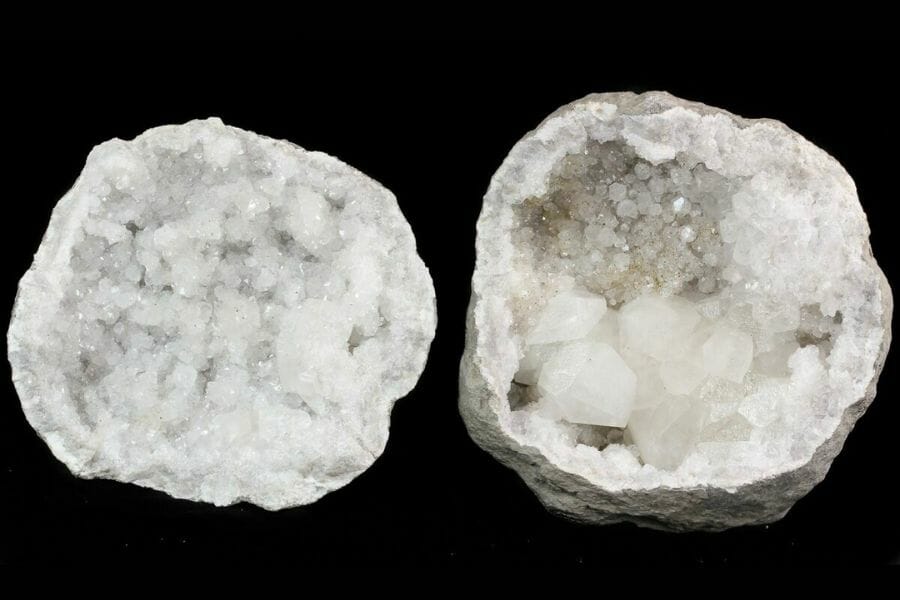
Although you may be aware of the great sites for gem mining in Missouri, not all of them have geodes, too. The locations we will discuss below may not be as widely known, but they are undoubtedly the best choices for finding geodes in Missouri!
Always Confirm Access and Collection Rules!
Before heading out to any of the locations on our list you need to confirm access requirements and collection rules for both public and private locations directly with the location. We haven’t personally verified every location and the access requirements and collection rules often change without notice.
Many of the locations we mention will not allow collecting but are still great places for those who love to find beautiful rocks and minerals in the wild without keeping them. We also can’t guarantee you will find anything in these locations since they are constantly changing.
Always get updated information directly from the source ahead of time to ensure responsible rockhounding. If you want even more current options it’s always a good idea to contact local rock and mineral clubs and groups
Weber Quarry
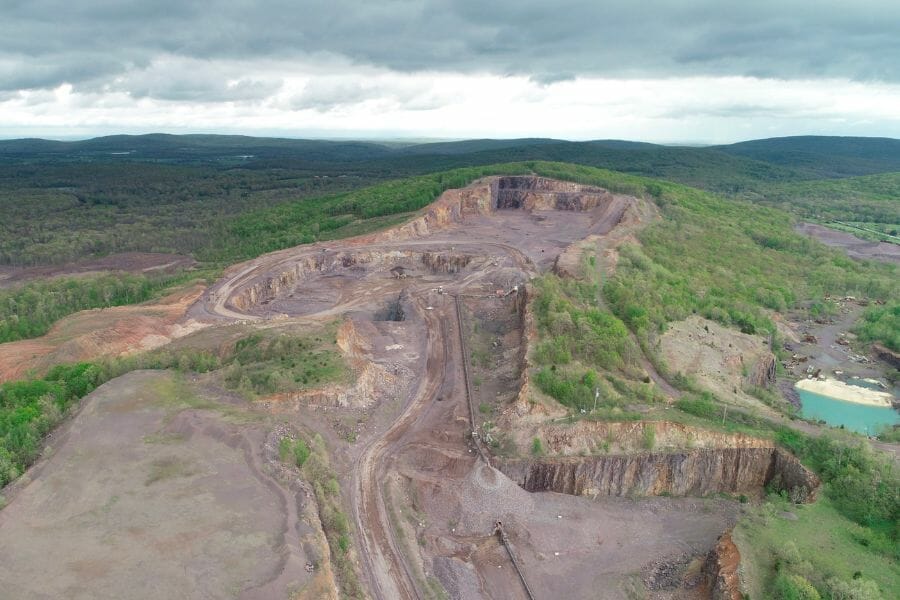
Weber Quarry is located in the southern part of our state, near the Ozark Mountains, so the geography here is stunning. Its terrain is rocky and uneven, so you’ll definitely want to wear some sturdy boots. But, hey, that just adds to the adventure, right?
Weber Quarry is known for its abundance of geodes, and they’re some of the best specimens you’ll find in the whole state! The geodes here range in size from small and unassuming to massive, and they’re filled with beautiful crystals that sparkle in the sunlight.
As long as you have a reliable GPS, getting here is easy. Just be aware that the roads can be a bit bumpy, so take it slow and steady. But before you pack your bags, make sure to check Missouri’s latest collecting guidelines.
Where we found geodes at Weber Quarry
The south area of the Weber Quarry in St. Louis contains some of its most amazing geode reserves, including specimens of Calcite geodes, Fluorite geodes, Millerite geodes.
DON'T MISS OUT ON ANY GREAT FINDS!
While you're out searching for Geodes you're going to find a lot of other interesting rocks and minerals along the way. The last thing you want to do is toss out something really interesting or valuable. It can be easy to misidentify things without a little guidance.
We've put together a fantastic field guide that makes identifying 140 of the most interesting and valuable rocks and minerals you will find REALLY EASY. It's simple to use, really durable, and will allow you to identify just about any rock and mineral you come across. Make sure you bring it along on your hunt!
Clark County
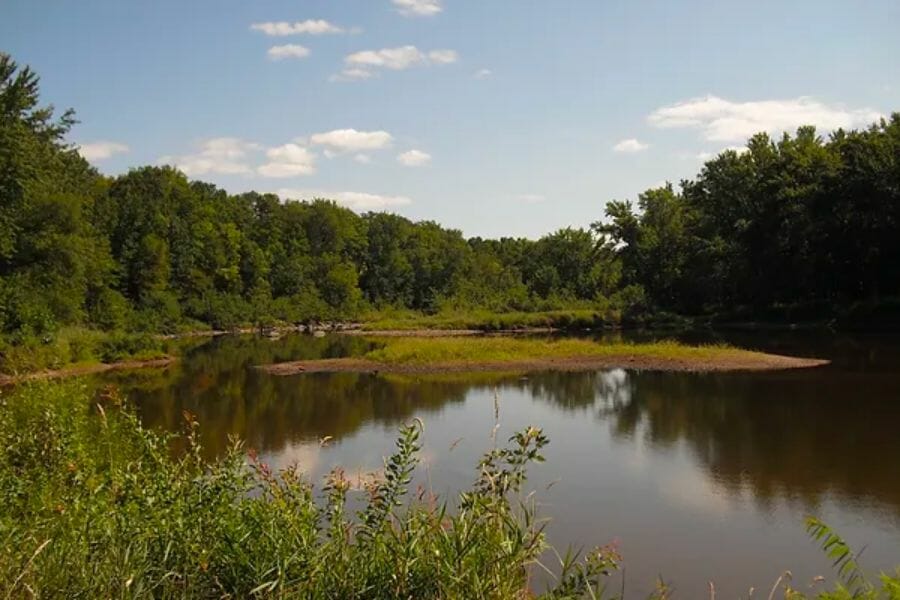
Rockhounding in Clark County is quite an adventure! This place is located in the northeastern part of our state, near the Mississippi River, so the geography is pretty flat, but there are some rolling hills in the distance. Its terrain is mostly farmland, with some wooded areas scattered around.
Clark County is known for its abundance of agates, which are some of the most colorful and unique rocks you’ll find in the Midwest. It’s also known to be the home of interesting geodes in our state. In fact, this is also a great place to find amazing Missouri crystals.
If you’re coming from St. Louis or another nearby city, hop on the interstate and head north, then take a few back roads to get to Clark County. Be prepared to do some walking and digging to find your geoedes. Oh, and bring sunscreen – the sun can be brutal out here!
Where we found geodes in Clark County
If you’re planning to visit here to find some geodes, these are the best spots to explore in Clark County:
- Alexandria
- Scheffer property
- Des Moines River
- Upland Scotland County border and downstream
- Old Iron Bridge on the river of Fox City
- Fox Road of Kahoka
- Easter Day Farm
- Upstream to Iowa border and downstream to Wayland Area
- Fox Road in St. Francisville
- Weaver’s Branch
- Sinottte property
Fox River

Located in the southwestern part of our state, Fox River is surrounded by lush forests and rolling hills. Its geography is stunning, with clear blue waters and rocky cliffs along the banks.
Its terrain can be a bit rough in some areas, so make sure you wear some sturdy shoes and bring plenty of water when you visit. But, when you see the gorgeous rock formations along the river, you’ll understand why a trip here is totally worth it!
Getting to the Fox River can be a bit tricky, especially if you’re not familiar with the area. The roads can be narrow and winding, so take it slow and steady. Once you get there, though, it’s easy to find a spot to set up camp and start exploring.
Where we found geodes at Fox River
To go to the best spot to find geodes in Fox River, travel 2.7 miles north on country road to bridge over its South Branch. The best collection area here is upstream to Scotland County border and downstream to its mouth at Fox River.
Weaver’s Branch
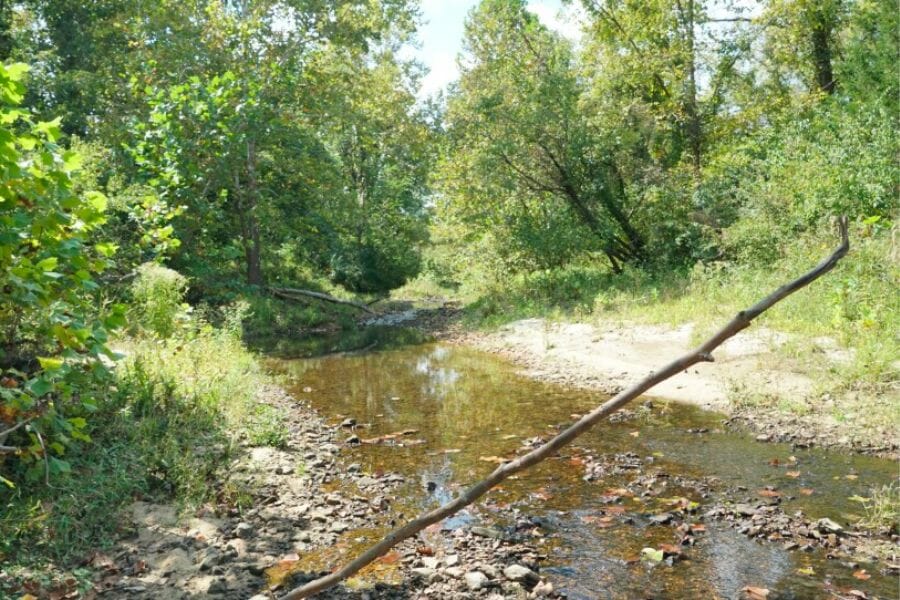
Weaver’s Branch is a great place that’s surrounded by hills and forests with crystal clear waters that flow through rocky channels and over small waterfalls. Because of this, its terrain can be a bit tricky as there are lots of rocks and boulders along the riverbanks.
The geology here is fascinating, with layers of sedimentary rock that have been twisted and folded over time to create some really unique patterns and textures.
Going here can be a bit of a challenge, especially if you’re not used to navigating winding country roads. But if you take it slow and steady, you’ll be rewarded with some stunning views and some great rockhounding opportunities— including some cool geodes!
Where we found geodes at Weaver’s Branch
You can find geodes in the banks of Weaver’s Branch in St. Francisville. Some of the ones you can find here may contain Aragonite, Barite, Calcite (pink), Chalcopyrite, Dolomite, Fluorite, Goethite, Honessite, Malachite, Marcasite, Millerite, Pyrite, Pyrolusite, Quartz, Smithsonite, Siderite, and Sphalerite crystals.
Des Moines River
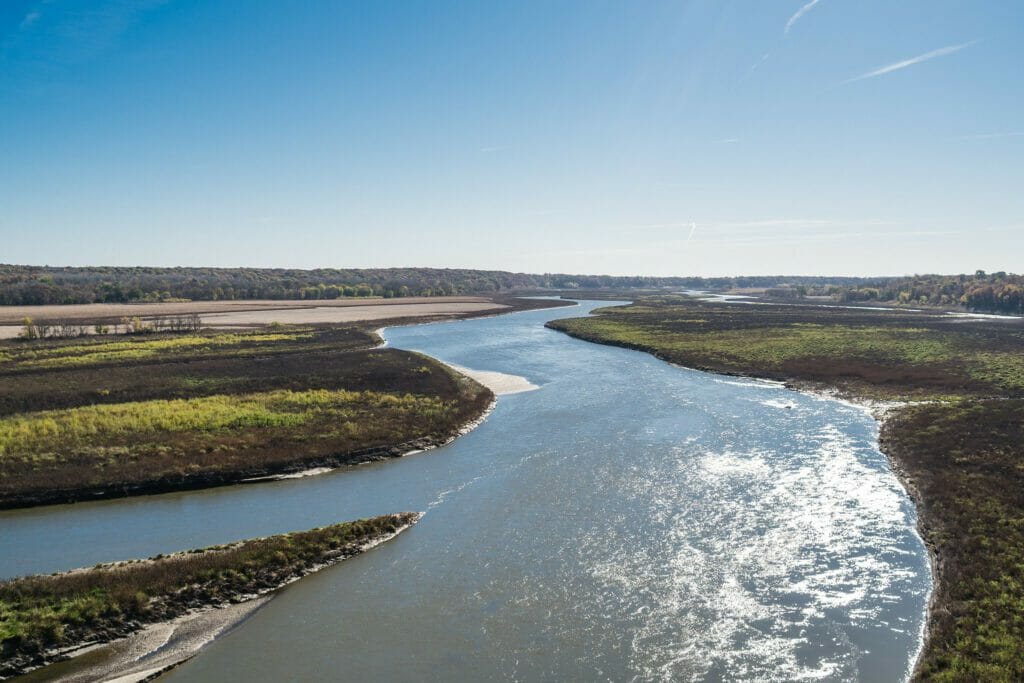
Des Moines is a meandering river that flows through the central part of the state. The geography here is really cool, with lots of steep bluffs and rocky outcroppings along the banks of the river.
Its terrain is a bit rugged in places, but the views are totally worth it. The river has some really breathtaking vistas, especially in the early morning or late afternoon light. The geology here is also pretty interesting, with lots of different types of rocks and minerals to be found.
There are lots of small country roads that wind their way through the hills and valleys going to Des Moines River, so if you’re planning to visit hre, be sure to bring a good map or GPS. Overall, we highly recommend Des Moines River to any rockhounders who are looking for a fun and challenging adventure!
Where we found geodes at Des Moines River
When you visit here, you can find geodes downstream of the river to its mouth and along its south shore, especially in virtually all ravines, washes, gullies, and tributaries entering the river.
Other Great Places To Dig For Missouri Geodes
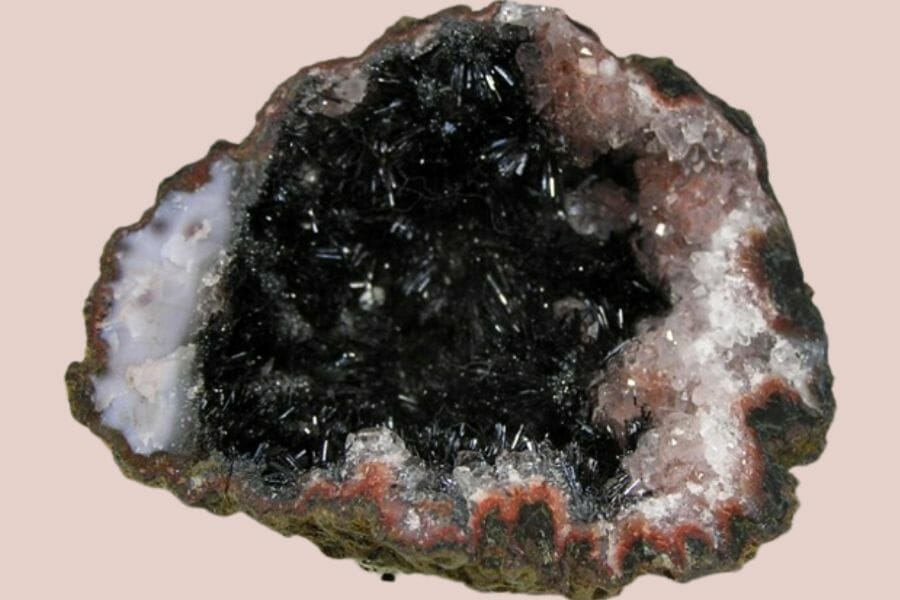
Although we’ve shared our top picks for finding geodes in Missouri, we have many more locations to suggest. To simplify things, we’ve organized them by county below. In instances where we’ve listed “county wide,” we’ve provided further recommendations in the following sections.
Our recommendations by county
| County | Location |
| Clark | County wide |
| Clark | Regional creek and river banks of Alexandria, Wayland |
| Clark | Gravel pit on the Scheffer property |
| Clark | Downstream on tributary of Des Moines River to its mouth |
| Clark | Upland Scotland County border and downstream to its mouth at Fox River |
| Clark | ½ mile north of the Old Iron Bridge on the north east bluff of the river of Fox City |
| Clark | Area shale outcrops along Fox Road of Kahoka |
| Clark | Easter Day Farm |
| Clark | Upstream to Iowa border and downstream to Wayland Area |
| Clark | In banks of all tributary streams |
| Clark | Base of all bluffs along the Fox Road in St. Francisville |
| Clark | In banks of Weaver’s Branch, St. Francisville |
| Clark | Along south shore of the Des Moines River, especially up virtually all ravines, washes, gullies, and tributaries entering the river |
| Clark | At the Sinottte property |
| Jefferson | 1 mile south on Richardson Road, on west side of I-55 |
| Jefferson | West side of I-55 in Arnold |
| Lewis | 3 miles east in Keokuk Shale along North Fabius Road and nearby streams |
| Lewis | Fabius River east of Durham |
| St. Louis | Weber South Quarry |
| St. Louis | 1.2 miles northeast on US-67 to St. Ferdinand Creek |
Common Geode-Hunting Questions
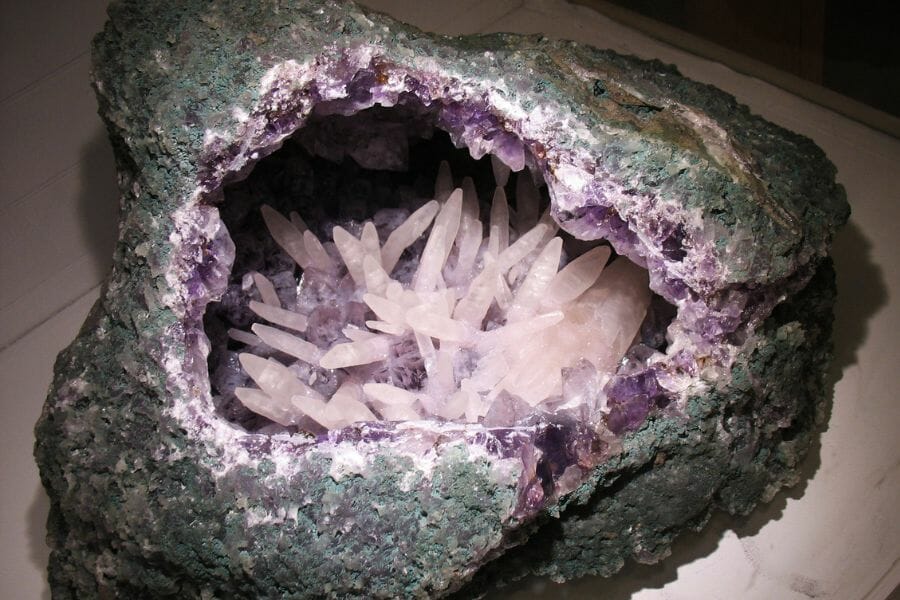
When people search for geodes in Missouri, they often have common frequently asked questions. We thought you might have these questions, too, so we’ll answer them here:
Where can you find amethyst geodes in Missouri?
Despite its abundance in geodes, Missouri does not have naturally occurring amethyst geodes. However, if you want to find these wonders, you can easily visit the local shops here that have them on sale. Below, we’ve listed down some of the best local shops here.
Is it illegal to collect geodes in Missouri?
It’s perfectly legal to collect geodes in Missouri if you abide by our local collecting laws. For government lands exploration, just make sure to check any existing local regulations. And of course for private lands exploration, always get permission from the owner first.
The Best Places To Buy Geodes In Missouri

While going through the hard and tedious work of finding geodes may be one of the most fulfilling experiences, it may not be everyone’s cup of tea.
So, if you’re one of those who just wish to get a beautiful geode without going through the whole search process, we compiled a list of our favorite local stores where you can easily buy them:
- Sheffler Rock Shop and Geode Mine – 26880 Topanga Canyon Blvd, Kahoka, MO 63445
- Amazon – Surprisingly, Amazon has great geode samples. They even have whole kits to help you crack them open!
- Peggy’s Rock Shop – 3705 State Hwy 76, Branson, MO 65616
- STL Rocks – 2003 Cherokee St, St. Louis, MO 63118
- Prospectors Crystals, Rocks & Gift Shop – 1640 Gravois Rd, High Ridge, MO 63049
- One of a Kind-Jewelry, Crystals, Metaphysical – 1819 W 76 Country Blvd Suite E, Branson, MO 65616
- Pathways New Age Books, Music, Jewelry, and Crystal – 11419 Concord Village Ave, St. Louis, MO 63123
- Fire and Ice Enterprises LLC – 29828 County Rd 196, Revere, MO 63465
Additional places to find geodes in nearby states
Check out our guides for nearby states if you’ve already tried all of our suggestions above or if you’re planning a trip outside of the state:
- Geodes in Iowa
- Geodes in Nebraska
- Geodes in Kansas
- Geodes in Oklahoma
- Geodes in Arkansas
- Geodes in Tennessee
- Geodes in Kentucky
- Geodes in Illinois
If you have any recommendations for our list please leave a comment below!

